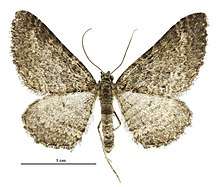Hydriomena clarkei
| Hydriomena clarkei | |
|---|---|
 | |
| Female | |
 | |
| Male | |
| Scientific classification | |
| Kingdom: | Animalia |
| Clade: | Euarthropoda |
| Class: | Insecta |
| Order: | Lepidoptera |
| Family: | Geometridae |
| Genus: | Hydriomena |
| Species: | H. clarkei |
| Binomial name | |
| Hydriomena clarkei (Howes, 1917) | |
| Synonyms | |
| |
Hydriomena clarkei is a species of moth in the Geometridae family. This species is endemic to New Zealand. It is classified as "At Risk, Declining'" by the Department of Conservation.
Taxonomy
This species was first described by George Howes in 1917 and named Chloroclystis clarkei.[1][2] Howes used a specimen collected by Charles E. Clarke in March at Flagstaff Hill in Dunedin and named the species in his honour.[1][2] George Hudson discussed and illustrated this species in his 1928 book The Butterflies and Moths of New Zealand.[3] In 1988 John S. Dugdale placed this species within the Hydriomena genus.[2] The holotype specimen is held at the Auckland War Memorial Museum.[4][2] The genus level classification of this moth is currently regarded as unsatisfactory.[5] As such the species is also known as Hydriomena (s.l.) clarkei.[5]
Description
Howes described the female adult of the species as follows:
♀︎ 25 mm. Head and appendages, thorax, and abdomen grey-brown. Forewings dark grey-brown, with the veins distinctly shown by being irrorated with black and grey to 2⁄3 across wing, and from there to termen irrorated with yellow and black ; a black line edges costa, interrupted by two white marks at 1⁄3, followed by three white marks at 1⁄2, two white marks at 3⁄4 , another close to apex : these marks all rather indistinct. Termen distinctly edged with a thin black line, interrupted by yellow dots at the ends of the veins. Hindwings grey suffused with darker grey, and with a rather indistinct series of transverse irregular fines ; termen distinctly edged with a thin dark line, small yellow dots interrupting it on the veins : cilia light grey with a dark-grey line at base.[1]
Distribution
This species is endemic to New Zealand.[5][6] It has occurred in Dunedin, Central Otago and at the Otago Lakes.[7] H. clarkei is considered extinct at its type locality of Flagstaff Hill.[7]
Biology and life cycle
The much of the biology of H. clarkei is unknown.[7] This species is on the wing in February and March.[1][3]
Host plants and habitat
The host plants of the larvae of this species are unknown but it has been reared in captivity on Geranium species.[7] Hudson states that the species could be located amongst shrub-land containing Dracophyllum and Leucopogon species.[3]
Conservation status
This moth is classified under the New Zealand Threat Classification system as being "At Risk, Declining".[8]
References
| Wikimedia Commons has media related to Hydriomena clarkei. |
- 1 2 3 4 Howes, W. G. (1917). "New Lepidoptera". Transactions and Proceedings of the New Zealand Institute. 49: 274. Retrieved 15 May 2018.
- 1 2 3 4 Dugdale, J. S. (1988). "Lepidoptera-annotated catalogue, and keys to family-group taxa" (PDF). Fauna of New Zealand. 14: 1–264 – via Landcare Research New Zealand Ltd.
- 1 2 3 Hudson, G. V. (1928). The Butterflies and Moths of New Zealand. Wellington: Ferguson & Osborn Ltd. pp. 96–97.
- ↑ "Hydriomena clarkei". www.AucklandMuseum.com. Auckland War Memorial Museum. Retrieved 15 May 2018.
- 1 2 3 "Hydriomena clarkei (Howes, 1917)". www.nzor.org.nz. Landcare Research New Zealand Ltd. Retrieved 15 May 2018.
- ↑ Gordon, Dennis P., ed. (2010). New Zealand inventory of biodiversity. Volume two. Kingdom animalia : chaetognatha, ecdysozoa, ichnofossils. Vol. 2. Christchurch, N.Z.: Canterbury University Press. p. 459. ISBN 9781877257933. OCLC 973607714.
- 1 2 3 4 Patrick, Brian; Dugdale, John S. (2000). Conservation status of the New Zealand lepidoptera (PDF). Wellington, N.Z.: Department of Conservation, New Zealand. p. 24. ISBN 0478218672. OCLC 154670803.
- ↑ Hoare, R.J.B.; Dugdale, J.S.; Edwards, E.D.; Gibbs, G.W.; Patrick, B.H.; Hitchmough, R.A.; Rolfe, J.R. (2017). Conservation status of New Zealand butterflies and moths (Lepidoptera), 2015 (PDF). Wellington, New Zealand: New Zealand Department of Conservation. p. 7. ISBN 9781988514383.